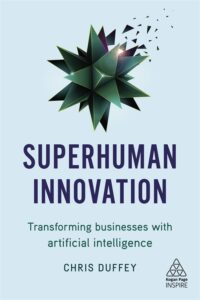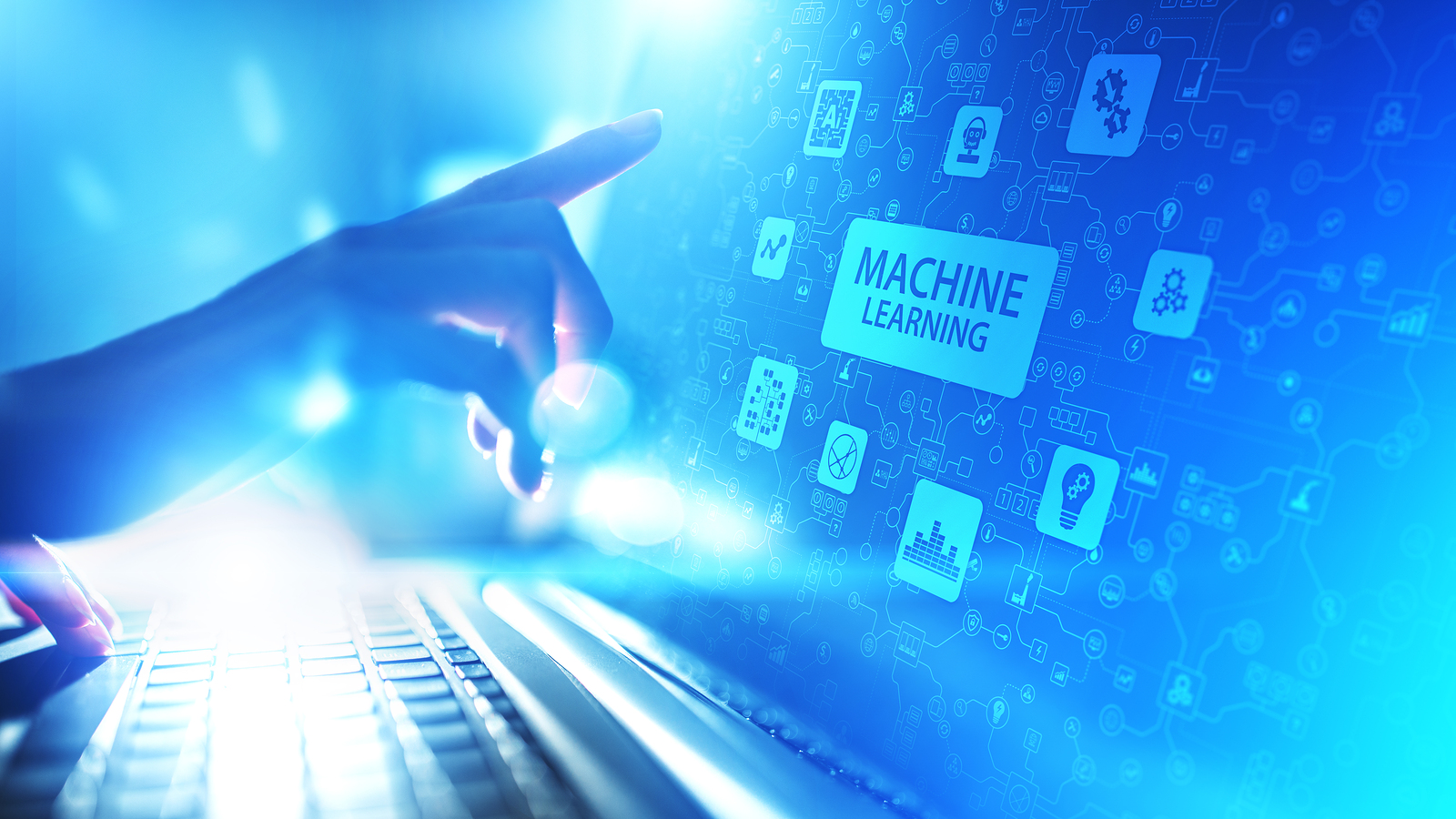The Electricity of Our Times
Artificial Intelligence (AI) is the new electricity of our times. That’s what Chris Duffey, creative technologist says about this incredible technology revolutionizing industries the world over. Chris spearheads Adobe Creative Cloud strategic development partnerships.
His new book Superhuman Innovation showcases how AI will supercharge the workforce, the world of work, and can be harnessed to deliver powerful change. It is a practical guide to how AI and Machine Learning are impacting not only how businesses, brands, and agencies innovate, but also what they innovate: products, services and content.
In this world of product and pricing parity, the delivery of superior service experience has become the new marketing, and the new real competitive edge. With AI, companies can harness the power of data, personalization and on-demand availability at the touch of an intelligent button.
Superhuman Innovation discusses how AI will serve the superstar innovators of tomorrow by enabling them to see deeper insights and set sail for higher goals. It unearths a powerful five-pronged model which describes how AI enables innovation through the offerings of Speed (facilitating work processes), Understanding (revealing and mastering deep insights), Performance (customization of delivery to customers), Experimentation (the iterative process of reinvention and feedback) and Results (tangible, measurable and optimizable results).
A Book Co-Written by AI (!)
How in the world?! That’s my first thought as I am talking with you. Chris, how did you co-write this book with Aimé, an artificial intelligence agent?
When I was a creative technologist working on digital health experiences, I saw first-hand how AI has the power to enrich people’s lives, and that was the source of inspiration for writing the book. We are now going through this interesting period with AI, and we go through it with every new technology – first we need to understand what it is and is not and then how to operationalize it within organizations both big and small to be able to leverage it to solve real world business and societal problems. With the recent advances of AI particularly around 2012, we had a convergence of computational power, access to a surplus of data and new AI techniques that allowed us to have this resurgence of use cases and applications.
So with this in mind, during the process of writing the book about the immense possibilities of AI as an amplifier of human ability at scale, I was inspired by a number of AI firsts: the first news articles created by AI, the first financial reports made by AI, the first car commercial created by AI, the first perfume created by AI, the first AI artwork sold at Christies, the first movie trailer created by AI… So I said to myself let’s not just write a book about AI, but let’s use AI to be a co-author. One interesting future conversation point here is, we do have a tendency to apply human traits to AI systems. In a sense it’s cognitive shorthand for contextualizing what an AI system can help achieve, so when we say co-author, we define it on 3 levels.
This framework of AI tools to help assist in the writing process was comprised of AI Voice Recognition, AI Content Understanding/Summarization, and AI Content Creation and Generation.
Voice Recognition and continuous dictation enables human-to-system interaction through a voice-user interface (VUI) for tasks such as speech-to-text, text-to-speech, voice editing, formatting, spelling, and sharing of documents—essentially a multi-model communication exchange.
AI Content Understanding and Summarization technology reviews and abridges databases, articles or research papers into quick, digestible content through approaches such as sentiment analysis, attribute labeling, and organization of higher-level concepts based on contextual understanding.
AI Content Creation and Generation is the ability for the system to develop concepts and ideas to aid the content creation process. Writing algorithms which were designed to emulate the human writing process helped contribute ideas, titles, content and responses.
The book’s format reflects and is written as the dialogue between myself and the AI system which we call Aimé, which stands for AI + Me, and is reflective of how AI has the ability to amplify the human experience.
AI to the Rescue
Talk a little about how AI will help solve some of our most intractable societal problems.
There are many dimensions to which AI can address not only a number of business and individual needs specifically with the ability to create personalizable experiences, but also to your point, AI has the ability to help address and solve broader societal problems as well.
AI is going to have an impact on humanity at the same level, or even more so, as the invention of electricity. Because of this we are calling it the Fourth Industrial Revolution, because it will cause the most dramatic change in human society in history. To put that in perspective, McKinsey recently noted AI is advancing 10 times faster and at 300 times the scale of the Industrial Revolution.
Consider what AI can accomplish. Autonomous driving could change the trucking industry, in effect virtually eliminating accidents and improving delivery times. Smart cities could reduce energy usage and pollution and improve the quality of life of inhabitants. There will even be smart factories, which will make products that are identical without flaws; smart mining, which will eliminate deaths due to cave-ins and toxic fumes; and smart farms, which could increase food productivity by several times while reducing water and fertilizer usage.
From a broad population health standpoint, consider dengue fever, one of the most virulent viruses in the world. Microsoft, for example, is working on a robotic mosquito trap that can distinguish one insect species from another. Small lasers are used to individually target the tiny insects. Since dengue is mosquito-borne, the robot could be used to combat the virus by identifying and killing the mosquitos. This application of AI is being used to fight dengue fever without using pesticides – that’s a game-changing application demonstrating how the technology will change human society.
The Fourth Industrial Revolution, automation of factories with robots and AI, will help resolve a number of issues. According to Volkhard Bregulla, Vice President of Global Manufacturing Industries at Hewlett Packard Enterprise, AI-enabled predictive maintenance allows manufacturers to achieve 60 percent or more reduction in unscheduled system downtime, which dramatically reduces costs that accumulate across production downtime, part replacements and inventory.
And these are just a few examples of how AI will help solve some of the world’s most pressing issues.
The Beginning of the AI Revolution
What do most business leaders get wrong when they think of AI?
 AI is gaining steam in business, industry and consumer markets, and we’re only at the beginning of the AI revolution. Since we are still at the very early days of the business application of AI, there is still a great need to demystify what exactly AI even is before businesses can most effectively apply it. To break it down a bit, there are essentially three forms of AI: narrow, general and superintelligent. When we talk about modern day AI, we’re talking about narrow AI, which means artificial intelligence that’s designed to perform specific tasks. Google Search is an example of a discovery task, and it’s become ubiquitous in its use throughout the population. AI chatbots are Q&A algorithms that can answer customer questions, and these AI applications can assist with customer service and help customer representatives with suggestions about what would be most valuable to the customer.
AI is gaining steam in business, industry and consumer markets, and we’re only at the beginning of the AI revolution. Since we are still at the very early days of the business application of AI, there is still a great need to demystify what exactly AI even is before businesses can most effectively apply it. To break it down a bit, there are essentially three forms of AI: narrow, general and superintelligent. When we talk about modern day AI, we’re talking about narrow AI, which means artificial intelligence that’s designed to perform specific tasks. Google Search is an example of a discovery task, and it’s become ubiquitous in its use throughout the population. AI chatbots are Q&A algorithms that can answer customer questions, and these AI applications can assist with customer service and help customer representatives with suggestions about what would be most valuable to the customer.
General AI, known as artificial general intelligence (AGI), is the notion that at some point AI will have human-equivalent intelligence. By that, I mean that it has a holistic understanding of its environment and can make conclusions on its own based on multi-sensory inputs without specific programming. AGI is achieved when AI intelligence is indistinguishable from human intelligence. There is much debate if and when AGI can ever be achieved.
Superintelligent AI is an approach that is often represented in Hollywood movies, which tends to anthropomorphize AI with an exponential increase of intelligence over humans. AI is represented as all-knowing, as able to solve problems and questions well beyond human capability or even understanding.
In current day applications of AI, we’re discussing narrow AI and its practical application. As an aside, the label ‘narrow AI’ doesn’t really do justice to what AI can do. Contrary to the implications of the term, the capabilities are vast. Narrow AI includes machine learning, deep learning, natural language processing, computer vision and machine reasoning. Ultimately, we first must understand the technology and its capabilities so we can better leverage it in the future.
How do today’s business leaders get ready for the future with AI?
One way to think about it in order to prepare for a future with AI is this idea: the more things change, the more they stay the same. Ultimately, AI is about being of service to humanity. At the end of the day it’s about a human centric approach, putting the human first. So, what I mean by that is, how can AI technology provide services, products and experiences that enrich people’s lives? The goal with AI is not simply to build smarter machines, but rather to build smarter organizations, smarter societies and ultimately a smarter world. But, you know, it’s hard or even impossible to predict where AI and similar technologies such as internet of things (IoT), mobility and robotics will wind up in a decade or two. Just look back 20 years, and you can see that no one could have predicted the ubiquity of mobile devices and smartphones. Not even the science fiction stories from the last century envisioned this explosion of the internet into our lives. Or just look at the impact Amazon has had on the economy; nobody could have predicted an online bookstore would become one of the most valuable companies in the world.
Technology has profoundly changed our daily lives, just look at how dramatically mobile phones have impacted everyone over the past few years. I remember flip phones that could only make calls, and now, in seemingly a blink of an eye, we have a powerful computer in our hands. The one thing we can be certain of is the rate of change will only increase, and human creativity and ingenuity within organizations will be even more valuable in the future.
Tell us a little more about some of the massive changes we will see as AI becomes more ubiquitous.
The vital fact to remember is: AI and none of the other emerging disruptive technologies are intended to replace human beings. Instead, humans and artificial intelligence will work together to create a brave new world. This will be a world where people are freed to use their natural creative abilities and their amplified intelligence without concern for the drudgery of mundane, repetitive and, quite frankly, boring tasks. This is the true mission of artificial intelligence. We talked earlier about the cultural shift of the connected customer and digital disruption, which leads us to the need to create experiences.
There are many things companies are doing to improve “the experience” at different touch points. To state the obvious, businesses need customers in order to expand and compete. And customers are won over to a brand by a great experience. More importantly, a good experience means customers will come back again. Bloomberg Businessweek recently conducted a survey, and they found that ‘delivering a great customer experience’ has become an imperative for businesses. Eighty percent of the businesses they polled put customer service as one of their top strategic objectives.
One example of creating a great experience with AI is with voice assistants such as Amazon Alexa in addition to smart speakers with assistants like Alexa Echo, and there’s also Google Home and Apple Homepod. With voice, there are tremendous opportunities for brands and companies to make things easy for the customer in meaningful ways. You can be brushing your teeth in the morning and ask Alexa about the temperature and traffic at the current time. It’s all about delivering information, services and products tailored specifically for the customer. That also applies in the business setting. Using their voices, physicians are now able to ask for the side effects of medications, truck drivers can plan their routes, and managers can book meetings. The applications are endless, and the future is exciting.
Virtual assistants such as Microsoft’s Cortana, Google Assistant and Siri are embedded and accessible on our phones, tablets and computers. In the very near future, we will even find these assistants helping us at the checkout in our local market and pumping fuel at a gas station. There is even an initiative called Product Box with the US Postal Service that is voice activated to make it easy to mail and track packages.
As AI becomes more ubiquitous, AI will become an indispensable Intelligent Assistant for extraordinary experiences.
Use the SUPER Framework
How will the SUPER framework help unlock competitive advantages for businesses?
We talked earlier about and laid the foundation of the technical aspects of AI. Now let’s talk a bit about the strategic model that will help unlock competitive advantages for business. We’re calling it the SUPER framework, and it will provide superhuman capabilities. SUPER is an acronym for Speed, Understanding, Performance, Experimentation and Results. It’s a powerful five-pronged model that harnesses AI as a catalyst for innovation. The super model provides five guiding principles that are necessary for successful AI implementation. These serve as the basis for an AI roadmap on which a strategy can be built. All five prongs – Speed, Understanding, Performance, Experimentation and Results – should be addressed by an AI strategy for a project to succeed.
To be successful, an AI strategy must first be designed around Speed. Consumers and businesses will not tolerate solutions that do not produce results quickly. Imagine an AI-driven telemedicine application that takes several days or hours to give a person an assessment about their illness. A mother with a sick child wouldn’t tolerate that kind of response time.
AI must also address Understanding. AI-enabled solutions must produce a greater understanding of a problem or situation. Consider an AI product that serves as a home alarm system. You would expect the system to learn about the environment and visitors and then make decisions based on that information. Such an alarm system could see, over time, that some people are never granted entry while others are always granted access to the building. Operating autonomously, the AI-enabled alarm could foreseeably grant or deny access based upon what it had learned, regardless of whether a person had a key or password.
Any AI-enabled product or solution must accomplish what it was designed to do – Performance of its given task and goal. For instance, a so-called smart ship, which operates with a minimal crew on board, must not only be able to navigate, but it must also be able to learn what to do during adverse weather conditions, understand how to handle a boarding by an unauthorized party such as pirates, and know what to do if it detects that a possible collision is about to occur.
Then there is the need for Experimentation, which forks into two aspects: curiosity within the AI model itself and how AI can spark curiosity and inspiration. Curiosity and inspiration are often needed to solve complex problems where the solution is not obvious or readily understandable. This inspiration can drive the development of new use cases and applications—and is essential to the process of developing this technology. MIT notes, ‘a computer algorithm equipped with a form of artificial curiosity can learn to solve tricky problems even when it isn’t immediately clear what actions might help it reach this goal.’
Finally, AI strategies must have Results that impact the business’s bottom line. Whether AI is used for products or services that were recently commercially launched or are mature in the market, businesses expect results.
The SUPER framework will unquestionably provide superhuman capabilities to organizations, their employees and their consumers. SUPER is based on the high-level premise that humans and machines working together are more powerful than individuals working by themselves. Whether a company is creating software, solving problems or inventing new products, these principles are all designed and tested to enhance the role of humans and elevate the human experience.
Is Aimé working on her next book already?
Thanks, there are a couple of thoughts running through our minds.
For more information, see Superhuman Innovation.

